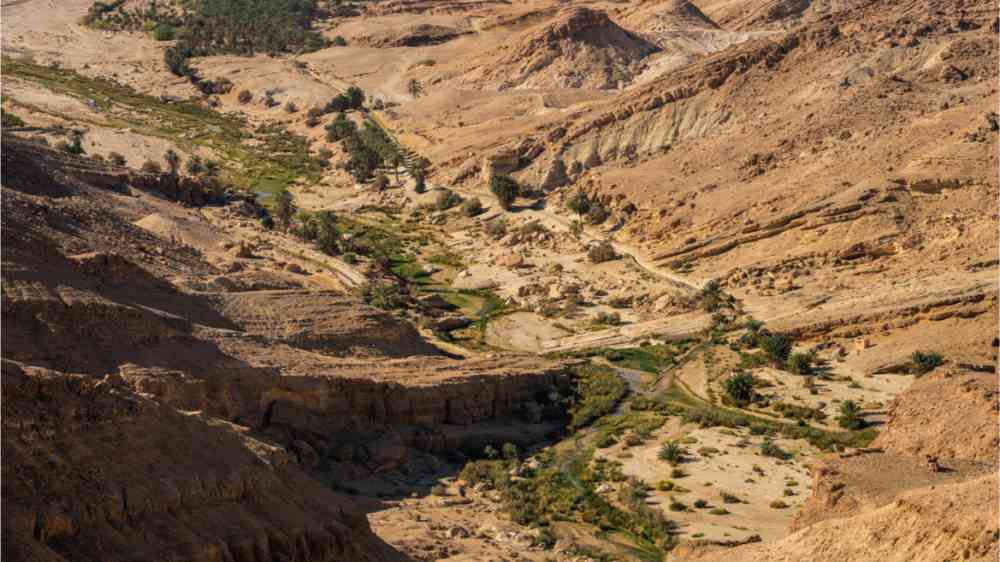Tunisia joins Morocco, Lebanon, and Jordan in using state-of-the-art drought management technology

With the first-ever Middle East and North Africa Climate Week just concluded, learn how improved drought preparedness is helping strengthen the region’s resilience to climate change.
Drought-monitoring technology that is currently being embedded in water and agricultural ministries in Jordan, Lebanon, and Morocco will now be implemented in Tunisia. The satellite-based enhanced composite drought index (eCDI) supports effective drought management by enabling authorities to identify, early on, the presence and evolution of drought. The technology was developed by IWMI and partners as part of the USAID-funded MENAdrought project. The team is now supporting the Government of Tunisia to implement the eCDI, along with seasonal rainfall forecasting technology, as part of a new initiative focused on strengthening the resilience of North African countries to the Water-Climate Change-Migration Nexus, with funding from the Center for Mediterranean Integration and the UK’s Foreign, Commonwealth and Development Office.
Drought is an ever-present danger in countries of the Middle East and North Africa (MENA) region. Although droughts are cyclical, natural hazards, their severity and ability to cause extensive loss and damage are increasing due to climate change. According to the United Nations Office for Disaster Risk Reduction, there were 338 disasters caused by drought between 2000–2019 globally, compared to 263 between 1980–1999. A semi-arid country, Tunisia has already experienced a decrease in rainfall of 3% over the past 30 years, during which time the average temperature has risen by 0.37°C per decade. With continued climate shifts forecast to reduce crop yields, having the capacity to identify droughts early on could help to underpin livelihoods and food security.
How the eCDI works
The eCDI works by identifying signals in environmental satellite data that denote the emergence of abnormally dry conditions. At the start of the wet season, if rainfall falls below the norm, this will be evident through a lower-than-usual precipitation signal in the eCDI. And, if this so-called ‘meteorological drought’ progresses, the soil-moisture signal will, too, fall below the average. Once desiccation reaches the point that the health of vegetation and crops is affected, causing an ‘agricultural drought’, this will become apparent through the vegetation health index in the eCDI. The eCDI compiles and outputs these signals to maps to show where no, mild, moderate or severe drought is present. This means that authorities can readily identify emerging dry spells and act quickly to take mitigating action.
IWMI and partners have been able to robustly validate the eCDI for Tunisia by comparing the satellite outputs with up-to-date meteorological and hydrological measurements. This has been possible largely thanks to Tunisia’s established policy of data sharing. And, building on work carried out under the MENAdrought program, IWMI and partners are now developing a seasonal weather forecasting system for Tunisia. They have been successful at forecasting precipitation in Morocco two to three months in advance; the hope is that, given the abundant rainfall observations available to test the technology in Tunisia, it may be possible to extend the forecast to four months in advance.
Being able to identify early on that a drought is emerging and then chart its progress could be hugely beneficial for Tunisia. Although agriculture employs 16% of the country’s workforce, Tunisia is highly dependent on food imports – particularly of wheat – and its national market and trade system are geared towards exporting goods such as olive oil. This makes it vulnerable to international food price hikes resulting from climate shocks. If authorities know that a drought is on the way, they can order food imports when prices are lower, rather than waiting until the drought has taken hold and demand has potentially pushed prices higher.
Building in-country capacity
In addition to helping Tunisia establish the eCDI as an operational system in the country, IWMI is providing capacity-building training workshops for seven staff from Tunisia’s General Directorate of Water Resources (DGRE). Those who attend will be able to learn from the experiences of Lebanon, Morocco and Jordan in deciding how to develop the system further. The ideal situation is for the eCDI and seasonal forecasting technologies to be embedded in agricultural, meteorological and finance departments as part of an integrated drought management system, with built-in triggers initiating specific responses from responsible parties – from declaring a drought, to making provision for herders, or activating financial support schemes.
“Making the eCDI and seasonal forecasting operational within Tunisia will support the country to expand its drought-management ambition – and can hopefully be a catalyst for wider evidence-based drought management in the Maghreb region,” says Makram Belhaj Fraj, agriculture and drought-management specialist for MENAdrought and the Tunisia initiative. “Across the region, it helps that countries are adopting a similar approach and can learn from each other’s experiences.”